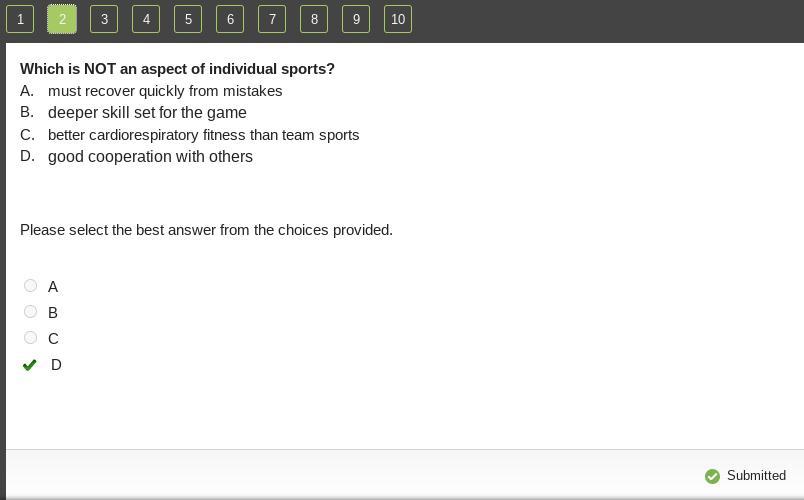Individual sports are activities that are performed by one person and do not involve any other competitors. Examples of individual sports include running, swimming, skiing, golf, tennis, and gymnastics. The success of an individual in an individual sport is based on their own skills and abilities, rather than the collective efforts of a team. However, there are some aspects which are not related to individual sports. These include team spirit, team dynamics, and the camaraderie that comes from being part of a team. Therefore, when talking about individual sports, it is important to focus on the individual’s performance rather than the collective effort of a team.
Teamwork
Teamwork is an integral component of many sports, but it is not an aspect of individual sports. Individual sports involve competing solely against oneself or against an opponent in a one-on-one matchup. While individual sports may involve strategies that require working with a coach or trainer, the athlete is ultimately responsible for their own performance. Team sports, on the other hand, involve more than one person and require collaboration and cooperation between athletes in order to achieve success.
Individual sports are focused on the performance of the individual athlete and the competition between themselves and their opponents. In individual sports, the athlete is solely responsible for their own performance, and team tactics or strategies do not come into play. Even in individual sports that require the use of a coach or trainer, such as swimming or gymnastics, the athlete is still solely responsible for their own performance.
In contrast, team sports involve more than one athlete and require collaboration and cooperation between team members in order to achieve success. Team sports also require tactics and strategies that are developed collaboratively by the team in order to achieve success. Team sports involve the coordination and cooperation of multiple athletes, which is not an aspect of individual sports.
In conclusion, while teamwork is a critical component of many sports, it is not an aspect of individual sports. Individual sports involve competing solely against oneself or against an opponent in a one-on-one matchup. Team sports, on the other hand, involve more than one person and require collaboration and cooperation between athletes in order to achieve success.
Camaraderie
Individual sports are those that are played by a single person, such as running, golf, and tennis. While there are many positive aspects to individual sports, camaraderie is not one of them. Camaraderie is the feeling of friendship and mutual trust that develops among a group of people. It is a unique form of bonding that is not typically found in individual sports.
One of the primary benefits of individual sports is that the athlete is solely responsible for his or her own success. This autonomy allows athletes to practice and hone their skills without the distraction of competing with others. It also allows athletes to focus on improving their own performance without worrying about the outcome of the game.
Another advantage of individual sports is that the athlete can choose the amount of time and energy they want to invest in the sport. This freedom of choice allows athletes to decide how much weight they want to put on different elements of their performance. This allows athletes to focus on areas that are important to them, while also allowing them to take a break when they need to.
Individual sports also provide athletes with a unique opportunity to learn the value of hard work and dedication. Athletes must be willing to push themselves to their limits in order to reach their goals. This can be an incredibly rewarding experience, as athletes learn to appreciate their own hard work and see the results of their efforts.
Although camaraderie is not an aspect of individual sports, the other benefits make individual sports an attractive option for many athletes. By taking advantage of the autonomy, freedom, and opportunity to learn the value of hard work that individual sports provide, athletes can gain a great deal of satisfaction from their experience.
Coaching
Individual sports, such as running, tennis, skiing, and golf, are activities often done solo. Unlike team sports, individual sports don’t rely on the involvement of multiple people for success. That means that the athlete is solely responsible for their performance, as no one else is there to help them. While individual sports are typically done alone, there are a variety of ways for athletes to enhance their performance, such as strength and conditioning, nutrition, and mental training. One aspect of individual sports that is often overlooked, however, is coaching.
Coaching is a key element of any sport, but it is especially important in individual sports. Coaches provide athletes with the skills and knowledge they need to perform to the best of their abilities. Coaches can help athletes develop strategies to improve their technique, provide support and guidance, and help athletes reach their goals. By having a coach, athletes can get personalized feedback, practice drills, and gain access to specialized knowledge and resources. In addition, coaches can help athletes stay motivated and reach their full potential.
In conclusion, coaching is not an aspect of individual sports, as it is an essential component of any successful athlete’s training. Coaches can provide athletes with the support, advice, and resources they need to boost their performance and reach their goals. Having a coach can help athletes maximize their potential and reach their full potential.

Leadership
Leadership is an important part of any team sport, but it is not an aspect of individual sports. Individual sports are competitions in which only one person competes against another, or against the clock. These sports are often seen as a test of a person’s physical and mental endurance, and as a way to measure one’s individual ability. The only person in charge is the athlete themselves, and it is up to them to put in the work and effort to reach their goals. As a result, leadership is not an aspect of individual sports as there is no one else to lead or follow. Instead, individual athletes must rely on their own motivation and internal drive to succeed.
Competition
When it comes to sports, individuals are often the only ones competing against themselves. While team sports rely on the collective performance of a group of players, individual sports rely solely on the performance of one person. These sports often involve a certain level of skill and physical and mental strength to perform well. However, one thing that individual sports do not involve is competition.
Competition is the most prominent aspect of team sports, as the team must work together to outplay their opponents. This creates a sense of camaraderie and a shared goal between the players. However, in individual sports, the players’ only goal is to beat their own personal best. There is no competing against another person or team, and the focus is on improving one’s own performance in order to achieve their desired results.
Individual sports are a great way to build confidence and better understand oneself. They allow athletes to practice self-discipline and push themselves to new limits. Through hard work and dedication, athletes can achieve a level of excellence and personal satisfaction that cannot be replicated through competition. While team sports involve the collective performance of multiple players, individual sports involve individuals striving to be the best version of themselves.
Equipment/Gear
Individual sports are activities that are performed without the need of any team members or opponents. Such sports are often focused on physical and mental abilities of an individual, and require a good level of fitness, skill, and coordination. While different individual sports may require different types of equipment or gear, there is one aspect that is not necessary for all individual sports: equipment or gear. Equipment or gear is not a requirement for all individual sports, as some activities, such as running, don’t require any additional equipment. Other individual sports, such as golf, require certain items, such as golf clubs, in order to play. However, the vast majority of individual sports are not dependent on any type of equipment or gear.
In conclusion, while some individual sports may require certain types of equipment or gear, such as golf clubs, it is not a necessity for all individual sports. Activities like running require no additional equipment, and many other individual sports are not heavily dependent on any type of gear. As such, equipment or gear is not an aspect of individual sports.
FAQs About the Which Is Not An Aspect Of Individual Sports
1. Q: What is not an individual sport?
A: Team sports such as basketball, football, and baseball are not individual sports.
2. Q: Are endurance sports considered individual sports?
A: Yes, endurance sports such as running, swimming, and cycling are individual sports.
3. Q: Is tennis considered an individual sport?
A: Yes, tennis is an individual sport.
Conclusion
In conclusion, team sports are not an aspect of individual sports. Individual sports are those that involve an individual competing against themselves or against another individual. The focus of individual sports is on developing and displaying the individual’s physical and mental skills. Team sports involve multiple players, often working together, and focus more on developing team dynamics and strategies.



